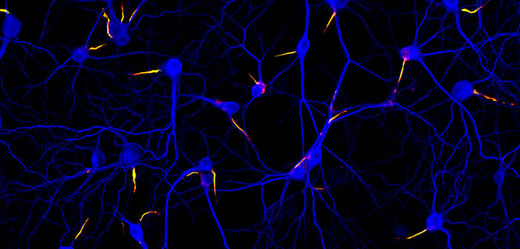
© The Journal of Cell Biology
For decades, researchers in the genetics field have theorized that the protein spools around which DNA is wound, histones, remain constant in the brain, never changing after development in the womb. Now, researchers from the Icahn School of Medicine at Mount Sinai have
discovered that histones are steadily replaced in brain cells throughout life - a process which helps to switch genes on and off. This histone replacement, known as turnover, enables our genetic machinery to adapt to our environment by prompting gene expression, the conversion of genes into the proteins that comprise cellular structures and carry signals in the brain.This new concept, described in a study led by researchers in the Department of Pharmacology and Systems Therapeutics at the Icahn School of Medicine at Mount Sinai, and at the Laboratory of Chromatin Biology and Epigenetics, The Rockefeller University, was published today in the journal
Neuron.
The study's findings argue against the long-held belief that histones, part of the chromatin structure that package and protect genetic material in chromosomes, are highly stable proteins in non-dividing cells like nerve cells.
The study authors argue that aging histones are instead constantly replaced with new histones, rather than being created once and remaining attached to DNA throughout a person's life. The newfound mechanism is epigenetic, meaning it fine-tunes gene expression without changing the DNA code we inherit from our parents.The study results revolve around the fact that, although some cell types, such as skin cells, constantly self-destruct and are replaced in an ongoing turnover that keeps tissues viable, others, such as nerve and heart cells, are programmed to perform specific functions with complex genetic memory involved, and do not often divide. With few exceptions, humans get one supply in the womb that must last a lifetime. Therefore, these cells must be highly adaptable, able to form new connections and behave differently depending on outside factors encountered.
The research team found that histone turnover regulates how genes in the brain are turned on and off in response to various stimuli, thereby allowing neurons to form new synaptic connections."These are very exciting results, creating a new front in the field of chromatin biology," said Ian Maze, PhD, Assistant Professor of Pharmacology and Systems Therapeutics at the Icahn School of Medicine at Mount Sinai. "By identifying this new mechanism of epigenetic regulation, or changes to gene expression caused by external and environmental factors, this work provides a novel conceptual framework for further studies aimed at identifying the molecular underpinnings of neurodevelopmental disease and psychiatric illness."
Specifically, the study examined a specific type of histone called H3.3 in human and rodent brains. H3.3 is a version of the histone H3 with a small random genetic change in its code, and thus a small difference in its protein structure. Cells with this version of H3.3 frequently turn over their histones.
To study histone composition in mouse nerve cells and related turnover, researchers fed young, post-weaning rodents a special diet containing heavy labeled lysines, a process known as staple isotope labeling of amino acids in cell cultures and live mice. When examining the nerve cells, researchers explored whether the H3.3 variant was labeled with that stable isotope ("new" histones) or if they were free of the label ("older" histones). This was accomplished by isolating individual neurons from the mice and performing mass spectrometry. The prevalence of the labeled H3.3 demonstrated the fact that the older histones had been replaced with newer ones, indicating histone turnover.
In humans, researchers used a technique called 14C/12C bomb pulse dating to measure turnover. The technique is based on the fact that high levels of radioactive carbon (14C) were released into the atmosphere during the 1950s and 1960s, when open-air nuclear bomb testing occurred following the Second World War. Researchers can take samples from cells - in this case, purified H3.3 samples from brain cells of postmortem human brains, and determine present 14C/12C ratios from the time of death against past atmospheric levels from the time of the subject's birth. As with the rodent observations, the researchers found that H3.3 turnover occurs in the human brain throughout life.
Additionally, the researchers deliberately manipulated H3.3 dynamics in both embryonic and adult neurons, confirming the role of histone turnover in neuronal plasticity. The findings thus establish histone turnover as a critical, and new, regulator of cell-type specific transcription in the brain.
"Histone turnover, shown through our work with H3.3, is essential for the behavior of brain cells," said Dr. Maze. "Furthering our understanding of how the brain works, learns, forms new memories and reacts to changes in the environment can help us to find new ways to treat neurodegenerative diseases and mental illness."
Reader Comments
to our Newsletter